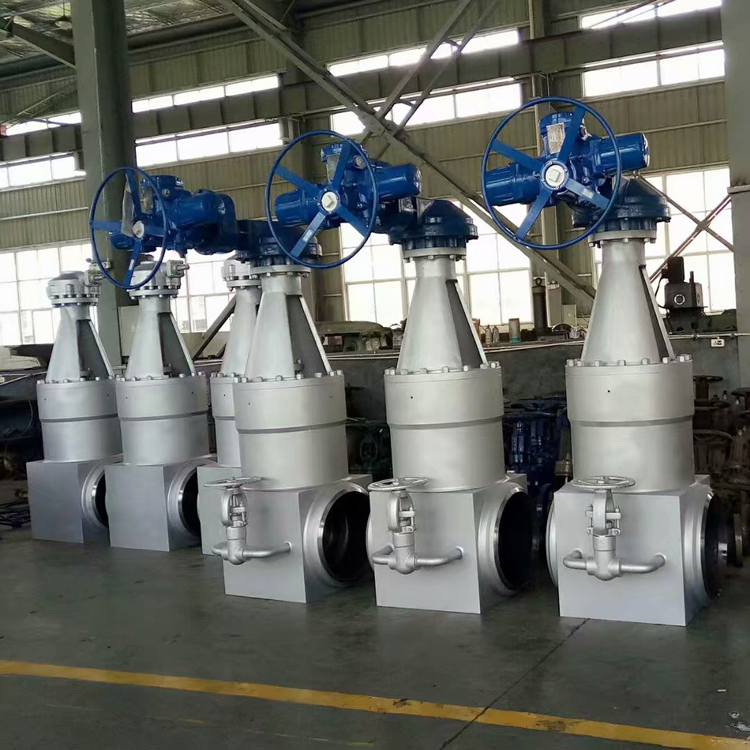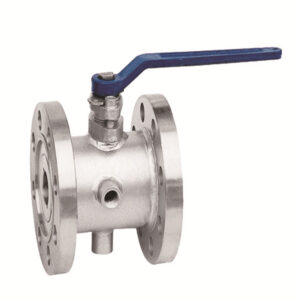Coal Chemical Industries
The coal chemical industry is the industrial sector that uses coal as a raw material and converts it into solid, liquid and gaseous fuels, or other chemicals through chemical processing.
The
control valve used in the coal chemical industry is subjected to a very difficult environment as multiphase flow composed of gas, liquid and solid usually flows into the control valve, in a high temperature, high pressure and high corrosion environment. Due to the particular steps that characterize the chemical process of coal, various control valves used in the production process are related to the stability and safety of production and play a fundamental role. S.
We now introduce specific analyzes on the application status of various types of key control valves, within different contexts and areas of coal chemical plants.
1. Uses and applications of valves in the coal chemical industry
Transportation of coal slurry (dust), including coal-water slurry (indirect liquefaction), coal-oil slurry (direct liquefaction), etc.
- Soot blowing system
- Waste water treatment system
- Slag discharge system
2. Characteristics of the valve control medium in the coal chemical industry
- The average temperature is high and the transport temperature can reach up to 350 ℃
- The working conditions of the gas-liquid-solid three-phase fluid are complex
- The working pressure is high and the pressure difference can reach more than 10 MPa, resulting in a high fluid flow rate
- The medium contains chloride ions, ammonia, strong corrosive media such as potassium salt, hydrogen sulfide or phosphoric acid.
3. Status quo of valves used in the coal chemical industry
The key valves of the coal chemical plant are basically based on imports. Due to the high price, short life of imported valves, the fact that the factory is far from China and the lack of timely after-sales service, the normal operation of coal chemical plants is complex. Fortunately, with the technical improvement of
domestic valve manufacturers and the increase of a large number of use performance, the location ratio of coal chemical control valves has also increased. The coal chemical plant must be shut down for maintenance every 3-6 months of operation. The key control valve is badly eroded and corroded and cannot work stably for a long period of time, thus limiting the normal operation of the device. The boiler feed water pressure of the coal chemical project is 16Mpa, and the steam produced by the boiler is basically 9.8Mpa and 540 ℃. Therefore, in the area of the boiler plant, the feed water control valve and the steam pressure reducing valve are very important and the cost is extremely high.
Boiler feed water valve
It is used to precisely control the liquid level of the steam drum. The water supply pressure is high (16Mpa) and the temperature is high (220 ℃). The coil structure can use the cage sleeve. The connection shape of the valve core and valve stem requires welding, and the shape of threads, pins and bolts is not used to prevent the valve stem and valve core from falling under high pressure erosion. The valve body material is usually WC6 or CF8M, the valve liner material is 304 or 316, and the valve stem material can be 304, 17-4PH (martensitic stainless steel, ultra high strength). If you select 304, then a force allowance of 1.5-2 times is required. The actuator can choose electric or pneumatic membrane actuator, considering the safety requirements of the control, it is necessary that the valve maintains the degree of opening in the event of an accident.
Minimum return valve of the boiler feed pump
Boiler feed pumps are often multistage pumps with degrees greater than 10, and the pressure difference between the inlet and outlet is extremely large. To ensure safe operation of the feed pump, the idle return valve is an important safety control accessory for the feed pump. Since the pressure difference is 16 MPa and the temperature is 220 ° C, the valve body and internal parts are greatly eroded, control is difficult and the price is high. In many places a pinch control valve with positioner is often used but, being difficult to control, it is often accompanied by vibration and erosion, and has a short life span. The true idle return valve is self-acting, and its core must be treated by spraying tungsten carbide. Furthermore, both the valve core and the body can be coated with the stellite alloy.
Steam pressure reducing valve
Now let’s especially consider the 9.8Mpa minus 1.0Mpa valve for which A, the CCI labyrinth sleeve pressure reducer is currently the first in the world. Although most manufacturers can also produce this
type of valve and have certain performance, the key core technology is still up their sleeve. Structural and manufacturing industries. The labyrinth decompression sleeve used by CCI is still the best calculated and produced by CCI. However, the connection between the valve stem and the valve plug should also avoid pins and threads. Note that other imported brands often add grinding or noise reduction orifices to the inlet or outlet of the valve, which actually play a role in pressure reduction, but this design brings major problems. Typically, this type of valve is welded and, if the orifice plate is damaged, it will be fatal to the entire system. Also, under low load, the decompression and noise reduction effect of the orifice plate will decrease very quickly and will not play a normal role.
The area of the air separation unit consists of:
low temperature valve
oxygen valve
molecular sieve regeneration valve
Cryogenic valve
It can be produced both in China and abroad, such as Flowserve, Fisher, Yamatake, Koso, etc. The valve body and valve liner material is mainly 316.
Oxygen vent valve
Used as an emergency vent of the air separation unit after oxygen overpressure and is characterized by a large pressure difference, fast acting speed and large amount of vent (depending on the design load of the gasification). In principle, the line speed should not exceed 25 m / s (it is related to the purity and pressure of oxygen and a common value is taken here). Therefore, for the oxygen relief valve with a high pressure difference, the generally selected material is Inconel625 or Menel500, and since the valve body and internal parts are made of this type of special material, the cost of these valves is very high.
The types of valves can be:
globe
sleeve
sphere (little used due to the price)
Three rod valve for molecular sieve purification system
According to the characteristics of the molecular sieve regeneration process, the pipeline is generally thick with diameter greater than 900mm up to 1500mm), and the regeneration frequency is also high, the fluid is relatively clean, and the pressure and temperature are moderate.
The valve can be sealed individually. For such large diameter pipes,
butterfly valves are usually used, possibly with triple eccentric.The three-stem valve is a butterfly valve with a special three-eccentric shape in which the rotating shaft is completely deviated from the center, similar to the structure of a robot arm.
During action, the valve plate first moves in the opposite direction to the fluid flow to separate the valve plate from its seat, then flips the plate over to overcome the friction between the plate and the valve seat. The gasification device is the most complex and is also the main device of the coal chemical industry. The valves used in this device are varied and have very strict requirements and, at the same time, it has an excellent relationship with the shape of the gasifier. Currently, gasifiers include Texaco, GSP, and four-nozzle coal and water slurry furnaces.
Coal sludge system and pulverized coal
Coal slurry is used as a control system for raw materials, coal slurry is used as transport equipment and flow regulation, and valves are used to control circulation and stoppage of coal slurry. According to the characteristics of the coal slurry, the first choice is the
ball valve, the fixed two-way watertight ball, the internal parts can be selected from 316 and above, and can be hardened by nitriding and stellite alloy coating . The control system of pulverized coal as a raw material is relatively complicated and the wear effect caused by pulverized coal is more severe. Of course, based on the characteristics of the 9 types of valves, ball valves remain the first choice. We report 3 points of detail that we consider important to highlight and which also apply to the slag valve for gasification waste:
1) In the selection of the valve bearing, try to ensure the sealing effect of the bearing, so as to prevent carbon dust from entering the bearing, which will cause wear and accelerate the damage to the valve.
2) Choosing the material of the valve seat butterfly spring, it is recommended to choose high speed steel such as SKH-23.
3) When installing the valve, the actuator mounting bracket or hook should be installed to avoid the influence of too heavy implementation on the valve stem and bearing.
We recommend these 2 types of valves:
Orbital ball valve: also known as elastic ball valve. It should be noted that the orbital ball valve must consider the impact of the material on the bearing, valve stem and actuator, and the sealing must be addressed here;
Disc valve: has high performance in use but must be chosen with two way seal and it is also necessary to consider the seal of the valve stem and actuator.
Slag block valve
There are 3 slag block valves and 1 slag block valve on the drain port of the block bucket. The slag block valve adopts a sealed metal fixed ball structure, which directly participates in the program control of the block bucket system.
Synthesis valve and other devices
Valve selection of methanol synthesis and other subsequent devices basically follows the basic requirements of valve selection.
Depending on the characteristics of the process, attention should be paid to:
Use 304L or 316L for temperature and low temperature
valve material selection.
For corrosive media such as hydrogen sulfide, in addition to 316L, 317L or two-phase steel can be selected.
For high toxicity or strong stimulation fluids The bellows seal type can be selected.
The production of polypropylene by the gas method requires high frequency valves and long switching times. At the moment, only a few products have good performance, so you need to pay attention to the selection.
Valves are currently basically divided into 9 categories:
1. Single seat valve
2. Double seat valve
3. Angle valve
4. Diaphragm valve
5. Ball valve
6. Throttle valve
7. Pinch valve
8. Eccentric rotary valve
9. Three-way valve
Based on the characteristics of the valve itself, the different requirements of the process and the
characteristics of the fluid, one of these valves is selected and optimized.
Of course, there are many other valves that are derived from the nine categories (such as plug valve and disc valve belong to the butterfly valve category). In addition to paying attention to the
valve type and material, accessories such as actuators, positioners, air pressure relief components and valve position feedback components are also very important when selecting the valve.


















